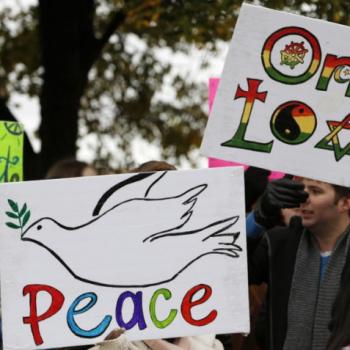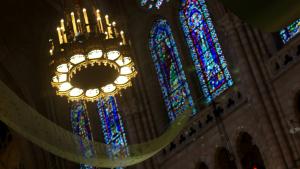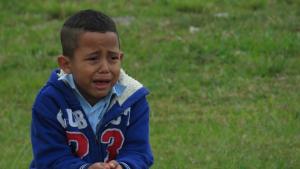A Time to Dance
Easter Sunday
Matthew 28:1-10
King Kamehameha Day is celebrated every year on June 11th. Growing up inHawaii, it was a day that rivaled the Fourth of July, for sure, when we would have the day off of school to celebrate. The whole family would wake up very early in the morning to make our way downtown and stake out a place onSouth King Street, as close to the front of I’olani Palace as we could get. The best years, we had spots where we could see the big gold statue of King Kamehameha and watch as passing floats in the parade paused to drape the statue with flower leis.
Every year, once we got settled with our mats and beach chairs on the curb, my grandmother would launch into her annual telling of the story. It was a story about her mother, who grew up in a small village in Kohala, on the Big Island of Hawaii, where King Kamehameha also was born. The story goes that one year when my great grandmother was a child, the whole region of Kohala was having a special day of celebration to honor King Kamehameha. Hawaii was still a monarchy at the time, and the queen, Queen Liliuokalani, was coming to Kohala for the big day. The whole town came out to line the streets, to watch the queen ride through town in the royal carriage. As the celebration swirled around them and the queen’s carriage approached, people bowed and kneeled all the while trying to catch a glimpse of the her.
The way the story goes, when the queen’s carriage got to my great grandmother and her parents, the queen asked the driver to stop the horses. She motioned to my great grandmother to approach the carriage and held out her hand to greet her. Every year the account of what the queen actually said to my great grandmother changed a little, but it was always something that acknowledged kinship between their families, and shared lineage all the way back to King Kamehameha. “Don’t ever forget you’re related to the king, children!,” my grandma would say.
Well, this was a super exciting story to the family friends who usually came to visit for King Kamehameha Day. But for me and my siblings, it wasn’t really all that exciting. In fact, after hearing the story so many times, we mostly tuned it out. Seriously, a lot of good it did us, anyway: there wasn’t a monarchy anymore, so we couldn’t really make that work to our advantage. Plus, we already knew that the whole royalty excuse never worked when protesting assigned chores. And grandma told the same story every single year—it really became rote and routine; it didn’t have quite the same impact on us that it did on our out of town guests who were hearing it for the first time.
Today is Easter Day, the day every year when we tell the same story again. Chances are, we don’t hear the story with the same emphasis that the first disciples did—after all, they lived it. I wonder: do we dust off our Easter best, show up at church because we should and listen like this? And suddenly there was a great earthquake; for an angel of the Lord, descending from heaven, came and rolled back the stone and sat on it. His appearance was like lightning, and his clothing white as snow. For fear of him the guards shook and became like dead men. But the angel said to the women, ‘Do not be afraid; I know that you are looking for Jesus who was crucified. He is not here; for he has been raised, as he said?”
You know, it’s 2000 years later; we’ve heard it all before. When you tell the story and hear it over and over and over again, it tends to become rather routine for us.
But I wonder what it would take for us to hear the story like they did, to experience the first Easter like we were living it right alongside those disciples? This is a story full of emotion and passion. It’s not a fable that’s told to disinterested ears the same time every year, but an utterly life-changing, completely transformational story…and, we need it.
We need it because resurrection changes our weeping to dancing…resurrection changes everything.
Do you remember the story? Listen to it again with new ears, with ears that can hear all the emotion involved:
It had just been a few days, a matter of hours, really, since Friday afternoon. Friday, remember, was the day when everything fell apart, when the thing they feared the most actually came to pass, when the sky suddenly went dark, dark as night, when the women stumbled up the hill behind their friend Jesus. He was the one carrying the heavy, heavy cross, his broken body struggling up the hill toward the place of the skull, but as they followed him up the hill they felt as if they, too, were carrying a heavy, punishing burden. No heavy cross for them; instead, it was fear, dread, really, that was weighing them down, pressing on their shoulders, tripping up their feet.
For days they’d watched in horror as their friend Jesus was arrested, tortured, condemned to die. They’d stood in the crowds, struggling to catch a glimpse of him. They’d cringed and shuddered at the sound of the whips. They’d sobbed as they heard him cry out in pain. And the weight of all these things, along with the heavy burden of despair and hopelessness pressed down on them until that Friday, when they gasped for breath as they followed him up the hill, sobbing.
They stood there, too, through the pounding of the nails; through the raising of the cross; through the last, gasping breaths he took. And when the other disciples had left—run away in fear to hide because they couldn’t keep walking with the weight of all that fear and pain—the women stayed, bearing the weight of grief, sinking to their knees in anguish, heavy with the darkness and horror that fell over them.
In Matthew’s version of the story, the women stayed. They stayed as night fell and Joseph of Arimathea, with permission from Roman authorities, came and took Jesus’ body down. They were even there, Matthew tells us, when Jesus’ lifeless body was placed in the tomb and a huge rock was rolled over the entrance of the tomb. Roman guards came to watch, to make sure no one stole Jesus’ body, and the women…the women who had been there all along but who had to leave for Sabbath observance without even embalming the body of their friend…turned to leave, their shoulders heavy and sagging with the weight of everything they’d seen and heard, all the hopelessness and horror that tripped them up and made them weep—weep with all the pain and despair of the loudest human lament ever heard.
Since the women were the ones who stuck with Jesus to the very end, it shouldn’t surprise us to read Matthew’s report that very early on Sunday morning, the first day of the week, it was the women again who made their way back to the tomb.
Their eyes must have been swollen and raw from crying; their bodies exhausted from lack of sleep and the rigors of intense grief. They didn’t know what would happen to them now that their friend was gone; all they knew was that they had to go and care for his body before too much more time and decomposition set in. So they gathered their courage and turned their tired, worn bodies toward the tomb again, each step weighted down by grief and pain.
It was Mary Magdalene and the other Mary who went to see the tomb, Matthew tells us, but just as then there was an earthquake and an angel, who—right in front of their eyes—rolled the stone away from the entrance to the tomb.
The angel was glowing and white, almost blinding in his appearance, and yet again it is the women who stick around to find out what’s going on. The text says the guards “shook and became like dead men”—maybe they fainted—but after all they’d lived through these past days, what could phase the women now? They’d tried to go and see Jesus’ body, to do what they’d come to do, but the angel told them there was no point—he wasn’t there anymore, he was raised, the angel told them, and he was waiting for them in Galilee. Go and tell the others, the angel said.
Right then, everything changed for those weary, world-worn women. And, really, everything changed for us, didn’t it? The women in Matthew’s text had come face to face with resurrection—with hope, with the totally impossible—and suddenly their whole world was different. The text says they hurried—can you see it? They ran with fear and great joy, the text says, wind blowing through their hair and whipping their robes as they scrambled down the path toward the place where the disciples were waiting, nearly skipping with the possibility and hope of it all.
All the weight they had been carrying lifted with the possibility that death was not the end.
Could it be? Could the possibility actually be real?
We ask the same question every year, don’t we? For we are people who live in the rational world, where grief colors our human experience, where failure and endings punctuate our experience, where death is a harsh reality, we sit here in the pews and we secretly wonder—don’t tell anybody!
We’re like the women, who stand on the sidelines looking in horror at the unfolding end of hope. And this is exactly, precisely why we need resurrection, why it must be real to us, even when all we can see is endings.
We need resurrection because it gives our faith wings: without it we are people of dusty books and antiquated sayings and wishful thinking.
We need resurrection because people we love have died, and without the promise of resurrection all we have to hang onto are fading memories.
We need resurrection because living within the structure of this world dries our spirits and shrivels our hearts.
We need resurrection because the weight of the world lies heavy on our shoulders and we can’t seem to be free of it.
I know we have many talented dancers in this congregation, but I myself am—sadly—not one of them. My short-lived career as a dancer stalled on the dance floor of a smoky Texas honkytonk, back in college, when I could not seem to consistently count to two in order to adequately do the Texas Two Step. My feet always felt like heavy weights; I could never seem to move with the possibility and fluidity of everybody around me.
But I’ve been thinking lately it might be time to give it another try. Forget the Texas Two Step…I am thinking it’s Easter, and we should learn to tango. You heard me. I’ve done some investigation, and it seems that the tango is the perfect Easter dance: earthy and dramatic, a dance where your whole body becomes part of the music and you are swept away with the possibility of the movement, where you are not enslaved to the counting, but where you become part of the rhythm of the music.
Yes, I think learning to dance the tango might be the best metaphor for why it is we need resurrection.
Here’s the first thing you need to know about dancing the tango: the tango always—always begins…with a backward step. It’s the perfect dance to living in the hope of resurrection, because we are people whose human experiences are colored by grief and pain and heaviness and death—so many backward steps.
But, like dancing the tango, the music of resurrection is relentless. It fills our hearts and thrums in our veins and will not let us go…until the story becomes real and resurrection becomes a possibility and our bodies begin to move with the rhythm of new life unconfined by the strictures of this world.
Like the women who followed Jesus through the pain of his last days, we walk through a human life that is weighed down with grief. If we try to dance at all, it’s a dance that is slow and cumbersome, confined to the stilted one-two-one-two of requirements and expectations, of dashed hopes and limited possibilities. Most of the time our hearts are heavy with weeping, lamenting the pain of our human condition. Without resurrection, we move through life like the women did that morning on their way to tomb, their hearts heavy with endings and hopelessness. They were living a time to weep, as are we, so many days of our human lives.
But it’s Easter morning: dry your tears. And listen now to the words of Ecclesiastes. For everything there is a season, and a time for every matter under heaven: a time to be born, and a time to die; a time to plant, and a time to pluck up what is planted; a time to kill, and a time to heal; a time to break down, and a time to build up; a time to weep, and a time to laugh; a time to mourn, and a time to dance.
It’s Easter morning; death is not the end for us anymore. Get up; throw off your grief; there’s no need to weep forever. Hope is here.
Would you like to dance?











